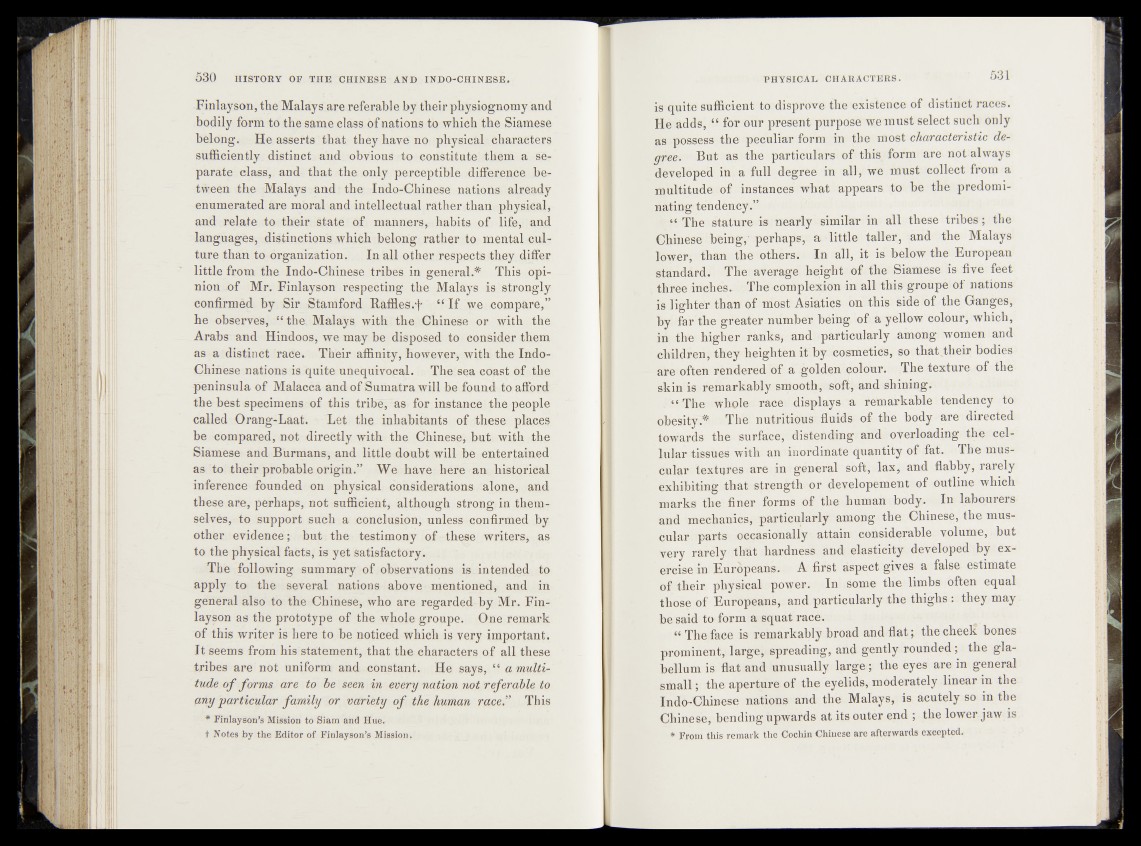
-Finlayson, the Malays.are referable by! their physiognomy and
bodily form to the same class Of nations to which the Siamese
belong. He. asserts that they have no ; physical; characters
sufficiently distinct and. obvious to constitute them a separate
class, and that the only perceptible difference between
-the Malays and the Indo-Chinese nations already
enumerated are moral and intellectual ratherdhan physical*
and relate to their state' of manners, habits pf life, and
languages, distinctions which belong rather to mental culture
than to Organization. In all other respects they, differ
little from the Indo-Chinese tribes in general.* This opinion
^of Mr. Finlay son respecting the Malays is; strongly
confirmèd by Sir Stamford Raffles.f “ If we compare,”
he observes, “ the, Malays with the Chinese or with the
Arabs and Hindoos, we may be disposed to consider them
as a distinct race. Their affinity, however, with the Indo-
Chinese nations is quite;unequi vocal. The’spa coast Of^the
peninsula of Malacca and of Sumatra will helpend- to afford
the best specimens of this tribe,"as for instancpifhe people
called Orang-Laat. Let the inhabitants of these plapps
be compared, not directly with the Chinese;-but with the
Siamese and Burmans, and little doubt will be-,:,entertained
as to their probable origin.” We have here an. historical
inference founded on physical considerations alone, and
these are, perhaps, not sufficient, although strong in-themselves,
to support such a conclusion, unless confirmed by
other, evidence; but the testimony of- these writers, as
to the physical facts, is yet satisfactory. .
The following summary of observations is„ intended to
apply to the several nations above mentioned, and in
general also to the-Chinese, who are regarded-by Mr. Fin-
layson as the prototype of the whole groupe. One remark
of this writer is here to be noticed which is very important.
It seems from his statement, that the characters of all these
tribes are not uniform and- constant. He says, “ a multitude
of forms, are to be seem, in every nation not referable to
any particular family or variety of the human racer This
* Flrilaygon’s Mission to Siam and Hue.
t Notes by the Editor of Finlayson’s Mission.
is quite sufficient'to disprove the existence of distinct races.
He adds, if for our present purposewre must select such only
asspossess. the peculiar form in the most characteristic degree.
But as the particulars of this, form are not always
developed in a full degree in all, we must collect from a
multitude of instances what appears to be the predominating
fetid eney*$ ^
“ ThP»statureisn early similar in all these tribes ; the
Chinese /-being,' perh ap s, a little taller, and the Malays
lower, than the others. In all,, it is below the European
standard. Theraverage height of the Siamese is five feet
three inches. The complexion in alf this groupe of nations
is lighter than of niostsAsiutics on this side/of the Ganges,
by far the greater number being of. a yellow colour, which,
in the higher ranks, and -particularly among women and
children, they heighten it.by cosmetics, so that,their bodies
are often rendered of a -golden colour. The texture of the
skin is remarkably smooth, soft, and shining;-
I “ The®whole / race displays a remarkable tendency to
obesity.* The*. nutritious fluids of the body are directed
towards-1 the surface, distending' and overloading»'the cellular
tissues with an inordinate quantity of >fat. The muscular
textures are in general sbfiqidax, and flabby, rarely
exhibiting that strength or developement of outline which
marks the finer forms of the human body. In labourers-
and mechanics, particularly among the Chinese, the muscular
parts occasionally attain considerable ’volume, but
very rarely that hardness and elasticity, developed by exercise
in Europeans. A first aspect gives a false estimate
of their physical power. In some the limbs often equal
thosf of Europeans, and particularly the thighs : they may
be said to form a squat race.
“ The face is remarkably broad and flat ; the cheek bones
p r o m i n e n t , - large,! spreading, and gently rounded ; the gla-
bellum is flat and unusually large; the eyes are in general
small ; the aperture of the eyelids, moderately linear in the
Indo-Chinese nations and the Malays, is. acutely so in the
Chinese, bending upwards at its outer end ; the lower jaw is
* From this remark the Cochin Chinese are afterwards excepted.